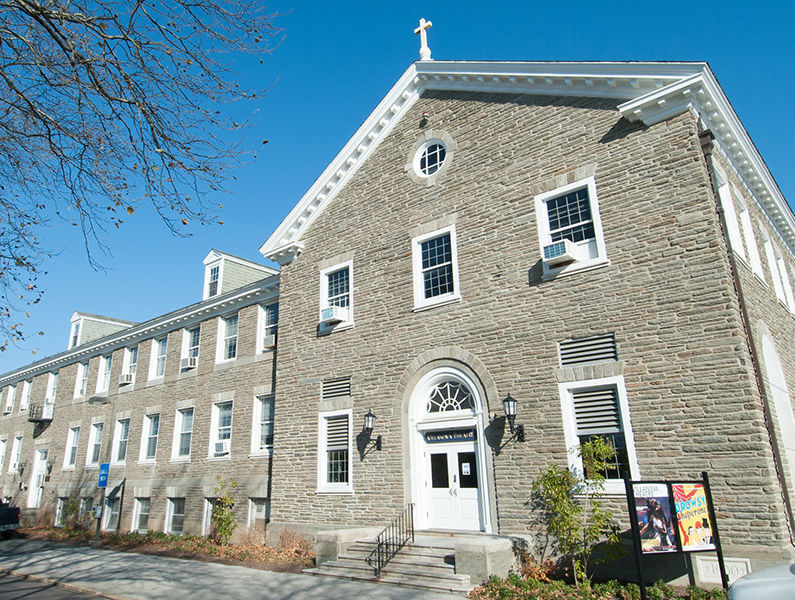Vasey Hall Should be Repurposed into a DEI Center
Courtesy of Villanova University
Vasey Hall is located on Main Campus.
November 10, 2021
On Aug. 4, 2020, the Black Student Union wrote a letter to Father Peter and the greater Villanova community with six action items for the University to improve life for Black and other marginalized students on campus. One of these action items is yet to be mentioned or addressed by the administration over a year later is the development of a diversity center –– a physical space on campus “that celebrates the minoritized identities of our student body, and that serves as a resource center to house the offices and programs which provide guidance for Black students, students of color and LGBTQIA+ students.”
I think the perfect place for this diversity center would be Vasey Hall on Main Campus.
Vasey, in my opinion, is currently an underutilized space at Villanova. It’s right across from the Connelly Center and steps away from Dougherty Hall and the Quad residence halls, which are all highly trafficked by undergraduate students. However, most undergrads don’t spend a lot of time in Vasey at all.
“I have never been in Vasey in the four years I’ve been here, and I wouldn’t know what its purpose was if I wasn’t signed up for an art class next semester,” senior Daryl Jucar said.
So if the undergrads aren’t using Vasey, then who is? Officially, it’s the home of the College of Professional Studies, Villanova Institute for Teaching and Learning, VUnited, the Studio Art department and the new Prince Family Veterans Resource Center. The ground floor was recently renovated, but the first and second floor offices and classrooms are relatively old and worn-down.
Vasey is also home to a black-box stage that was previously used by the graduate program in Theatre, but it has become more of a multipurpose space since the construction of the Mullen Center last year. It would also make more sense for the College of Professional Studies’ headquarters to be in a place on campus that’s more accessible by cars and public transportation (instead of the pedestrian-focused Quad) like Garey or St. Mary’s.
The University has several different offices dedicated to DEI, including the Office of Diversity, Equity and Inclusion, the Center for Access, Success and Achievement and the Office of Intercultural Affairs. Although each office has a unique mandate (institutional, academic/professional and social DEI efforts, respectively), if all of these teams of faculty were located in the same physical space, it could promote more cooperation among them.
A dedicated building would also make it easier for people to figure out where to go in the event that they’re looking for support. Many students, especially those who are new to Villanova or new to DEI work, may not be familiar with the specific jurisdiction of each office. If we want members of our community to engage in inclusion efforts, we should remove as many roadblocks as possible and make the path to accessing ideas and support seem welcoming.
Some of our peer institutions have outstanding examples of diversity centers that we could draw inspiration from. When I walked around Northeastern’s campus, I was struck by the brownstones and sophisticated glass buildings that housed the John D. O’Bryant African American Institute, Asian American Center and Latinx Student Cultural Center, among others, if they can find space for standalone DEI buildings in downtown Boston, so can we.
Williams College is in the process of combining three adjoining DEI offices to create one unified Davis Center containing a library, study and meeting space, offices, an outdoor classroom and “celebration lawn.” Williams’ website describes the goal of this renovation to be “[going] beyond inclusion by providing every student the opportunity to experience a fundamental sense of belonging on campus and ownership of the college.”
It’s important to have externally visible reminders of DEI, especially at a PWI such as Villanova, to both symbolically demonstrate its importance to us and pragmatically facilitate an enriching environment for marginalized students. Walking through the building, one could stumble upon a club meeting that you were previously unaware of and decide to learn more about it. In an LGBTQ+ study space/lounge, one could strike up a conversation with someone that isn’t ready to be ‘out’ yet to the rest of campus and offer them advice or friendship.
Most importantly, establishing a physical presence dedicated to marginalized communities is a way to show them that we want them to take up space on campus. ODEI is tucked somewhere inside Tolentine. OIA has a tiny office upstairs in Dougherty.
I think the University’s diverse students deserve more than this and deserve for their administration to proudly display their commitment to creating a more inclusive campus and world.


